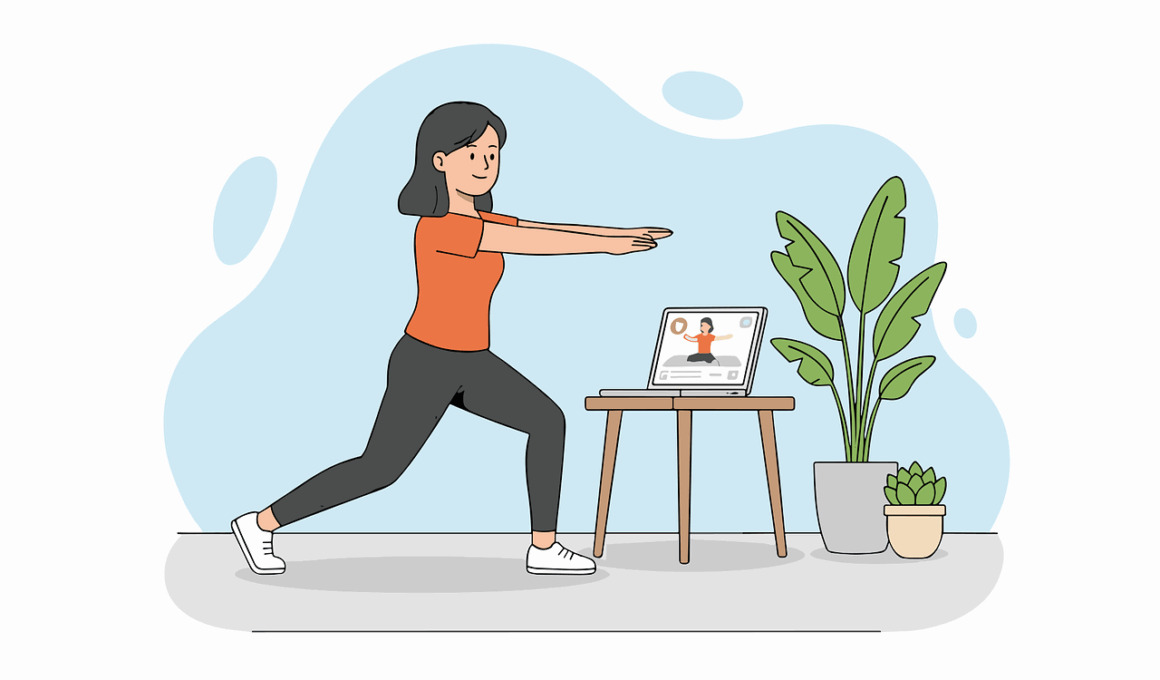How to Modify Your Home Workout Plan to Prevent Plateaus
Creating a home workout plan is essential for maintaining fitness, especially during periods when gym access is limited. To formulate an effective plan, consider incorporating various types of exercises. Focus on these key components: strength training, cardiovascular activities, flexibility work, and active recovery. Strength training involves bodyweight exercises or resistance bands, which you can easily do at home. Cardiovascular exercises enhance endurance, so consider options like jumping jacks, running in place, or dancing. Flexibility work, such as yoga or dynamic stretches, keeps your body limber and prevents injuries. Lastly, ensure you schedule active recovery days, promoting your muscle recovery while keeping you engaged. Balance is crucial in your plan, catering to different fitness levels and personal preferences. Including different modalities also helps to keep workouts interesting while challenging your body in new ways. Consistently monitoring your progression is crucial. Track your workouts regularly in a journal or app to identify what works and where changes are needed. Adjustments will help prevent plateaus, ensuring continued growth in strength and endurance.
As you progress in your fitness journey, it is important to listen to your body. If you notice a plateau, signal that it’s time to modify your home workout plan. There are several strategies to employ when making these adjustments. First, you can increase the weights or resistance used in strength training. For example, you can begin using heavier resistance bands. Second, altering the number of reps and sets can stimulate new muscle growth. Try increasing the repetitions in your current routine or add more sets to enhance the workout intensity. Third, varying your exercises can yield significant benefits. For instance, incorporate new exercises targeting the same muscle groups. This keeps workouts fresh and can reignite results. Don’t forget to prioritize rest and recovery, and allow your muscles to heal between workouts. A well-structured active recovery day could include light activities such as walking or yoga sessions. Finally, staying motivated involves setting short-term, achievable goals that reflect your fitness aspirations. Celebrate these milestones, keeping you enthusiastic and engaged in your home workout journey.
Incorporate Variety to Break the Routine
To avoid stagnation in your fitness regimen, incorporate variety into your home workout plan. Workouts that become predictable can lead to diminishing returns; hence think creatively about how you approach training. One effective method is rotating workout modalities such as strength training, cardio, and flexibility-focused sessions. Each type of training provides a unique challenge and varying benefits. Strategies like using high-intensity interval training (HIIT) add speed and endurance variations by alternating between high-effort bursts and rest intervals across your sessions. Additionally, explore outdoor workouts, which can infuse fresh air and scenic views into your routine. Consider activities like hiking or interval sprints in a park to elevate your heart rate. Adapt your warm-up and cool-down sessions, ensuring they align with your main workout objectives, while maintaining overall mobility and support for muscle groups taking part in various workouts. Incorporating group fitness sessions or virtual classes can also enhance motivation. Engaging socially creates accountability on various platforms, pushing you to adhere to your planned activities.
Monitoring your workout intensity is crucial when modifying your home workout plan. Keep a workout journal or digital tracking tool to help you gauge effort levels effectively. Attention to heart rate responses helps guide your workout design—aim for target heart rate zones, typically between 50% to 85% of your maximum heart rate for effective fat burning and performance improvement. Employing methodologies like Rate of Perceived Exertion (RPE), where you rate your effort on a scale of 1 to 10, serves as a reliable alternative. Balancing various workout intensities throughout the week optimizes overall adaptations and avoids burnout. Scheduling different sessions to engage in both lighter and high-intensity training allows your body to recover in between sessions while providing a fresh perspective on fitness objectives. Aim to allocate time specifically for high-intensity efforts during the week while ensuring adequate rest days. Numerous mobile apps provide thorough metrics that analyze workout performance and progress—use these tools judiciously to make educated decisions surrounding workout modifications. Tailor your selections based on what metrics yield impressive results appropriate for your goals.
Setting Realistic Goals
Establishing realistic fitness goals enhances the focus and effectiveness of your workout plan. Firstly, embrace the principle of SMART—Smart, Measurable, Achievable, Relevant, and Time-bound objectives—when setting your targets. An example of a SMART goal might be, “Complete three full-body workouts a week for the next month.” Adapt your goals to reflect personal motivation and avoid feelings of frustration or helplessness. Begin with short-term milestones achievable within weeks to ensure consistent motivation. As you meet these objectives, re-evaluate and set new goals that elevate the challenge. Periodically reviewing your progress provides vital feedback on what works and establishes necessary changes to prevent plateaus. Consider leveraging motivational tools, such as fitness trackers and group classes, to consistently fulfill your goals. Engage others with similar aspirations to provide accountability within your fitness community—your journey could offer support to others as well! Cultivating a supportive environment fosters commitment and keeps you focused on success as you maintain your workout plan. Use rewards, lazy days, and celebrating small victories to boost the experience of your home workouts.
Nutrition significantly impacts your workout performance and progression. Adequate fuel is crucial, especially when engaging in intense workouts. Pay attention to sustaining proper nutrition before, during, and after your workouts. Begin with a well-balanced diet, characterized by lean proteins, healthy fats, whole grains, and a rainbow of fruits and vegetables. Carbohydrates are essential for maintaining energy levels; consuming complex carbs like quinoa or sweet potatoes can provide a much-needed performance boost. Following workouts, ensure adequate protein intake to repair muscle fibers and replenish glycogen stores. Explore post-workout options, such as banana and yogurt smoothies or protein shakes to expedite recovery. Moreover, hydration remains equally vital—aim for at least 8-10 cups of fluids daily, increasing this amount on days incorporating more strenuous or prolonged workouts. Include electrolytes in your routine to further assist recovery, especially after intense sessions. Realize that both your exercise and nutrition components play complementary roles in achieving fitness goals; investing time in meal prep can enhance your overall performance, engendering consistent progress along your home workout journey.
Staying Consistent and Motivated
Consistency is foundational in any home workout plan. Following through on your strategy requires strong personal motivation and discipline. To establish a routine, structure your workouts at consistent times, treating them like important appointments. Incorporating pleasing aesthetics within your workout environment also encourages adherence. Keep your workout spaces organized, visually appealing, and equipped with necessary gear. Personalizing the area with motivational quotes and imagery or inspiring art creates an inviting atmosphere. Additionally, register for virtual fitness communities that provide daily inspiration and encourage sharing of achievements amongst peers. The support found in collaborative platforms fosters accountability and enhances motivation. Explore new workouts via various media, such as fitness apps or online classes, maintaining excitement within your routine. For beginners or those struggling, consider scheduling group workouts with friends or family; this communal effort enhances enjoyment, reducing the odds of skipping sessions. Focus on what produces the greatest results while establishing a rewarding relationship with fitness, nurturing long-term habits and personal satisfaction. Ultimately, finding joy in your home workouts propels you towards success, warding off plateaus effectively.


